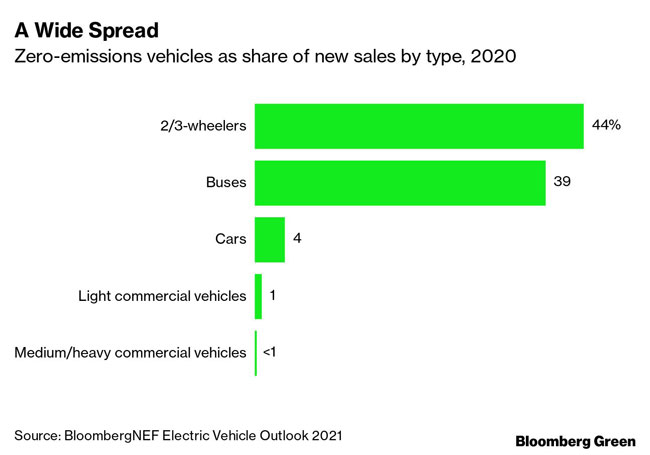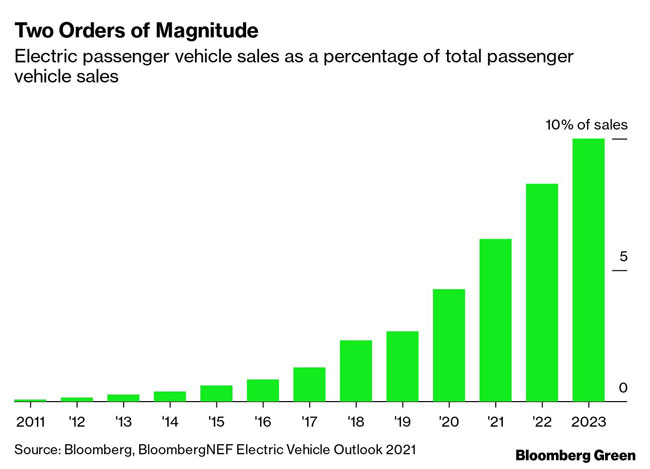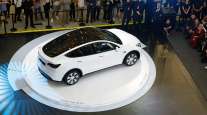Peak Internal Combustion Engine May Already Be Years in the Past

[Ensure you have all the info you need in these unprecedented times. Subscribe now.]
The world hit a transport milestone in 2017, though most people wouldn’t have noticed it at the time.
That year, consumers bought more than 85 million automobiles, a sales volume that declined in 2018, and again in 2019, and then plummeted in 2020 due to COVID-19. Meanwhile, sales of electric vehicles rose, and rose again, making EVs the auto industry’s only growth market — and meaning that we almost certainly hit peak internal combustion engine car sales four years ago.
The future looks even more electric, according to BloombergNEF’s annual Electric Vehicle Outlook. The report is full of bold conclusions. For one, it sees mostly electric vehicles sold by the 2030s and mostly electric vehicles on the road by the 2040s — and that’s just the business as usual scenario. In a net-zero emissions world, EVs would comprise 100% of passenger vehicle sales just 15 years from now, with all other classes of road vehicle — from two-wheelers to heavy commercial trucks — being either fully electric or fuel cell-powered by the early 2040s.
Creating this sort of scenario is important in the current moment, when more and more businesses are committing themselves to a net zero path. Also important: describing where the industry is right now.

Electric cars get a lot of attention, but they’re only one type of now-electrified road vehicle. Last year, EVs were more than 4% of total passenger car sales and 1% of the commercial vehicle market, at most. Meanwhile, electrics were 44% of electric two- and three-wheeler sales, and 39% of bus sales. As efficient as modern car factories are, they won’t be able to keep pace with an e-scooter factory targeting 10 million units a year.
Passenger cars have a long way to go to catch up. But the rate of change so far has been notable. Total new car sales value last year exceeded $2 trillion, even with a massive overall sales drop-off. EVs are already a $100 billion-plus annual business, with a striking growth rate.
In 2011, EVs were 0.1% of total passenger car sales, but BNEF believes they could be 10% of sales by 2023, a 100-fold increase in a little over a dozen years.
It’s worth thinking about the coming growth in passenger car EVs from a company’s perspective. A raft of new models are coming, many from century-old automakers. Some of them are old branding on new vehicle types, such as Ford Motor Co.’s Mustang Mach-E, which is already being manufactured more than its combustion engine sports coupe namesake.
But more of the incipient EVs are comparable to existing internal combustion models. As an example, the best-selling vehicle in the U.S. for the past four decades, the F-150, will soon have an electrified doppelgänger, the F-150 Lightning. Once it hits the market next spring, a few things could happen: it could eat into regular F-150 sales; it could eat into other manufacturers’ full-size truck sales; or it could absorb sales from other vehicle classes — say, SUVs.

Data already exists on how one company’s comparable models with different powertrains might evolve on the sales front: Porsche. Porsche doesn’t have many models — most have been sold for years or decades — therefore its new introductions are potentially in competition with its existing offerings. Porsche sells two internal combustion SUV models (one of which is available as a hybrid), and now two sedans: the combustion (and hybrid) Panamera, and the all-electric Taycan.
The Taycan was 7% of Porsche’s North America quarterly sedan sales when it was introduced. Two quarters later, it was just under half. In the first quarter of 2021, six quarters after it was introduced, the Taycan was 82% of sedan sales, even as the total sedan market has grown.
Porsche has managed to grow its sedan market with a new model, but the competition between its incumbent and its new entrant is also crystal clear. The electric Taycan could push its combustion-engine sibling to the brink — too small a market to be worth a model refresh.
It’s a competition, in miniature, that the global auto market will soon face across the board. All of its growth is electric, and at a certain point, that growth comes at the expense of combustion engine sales.
Want more news? Listen to today's daily briefing below or go here for more info:




